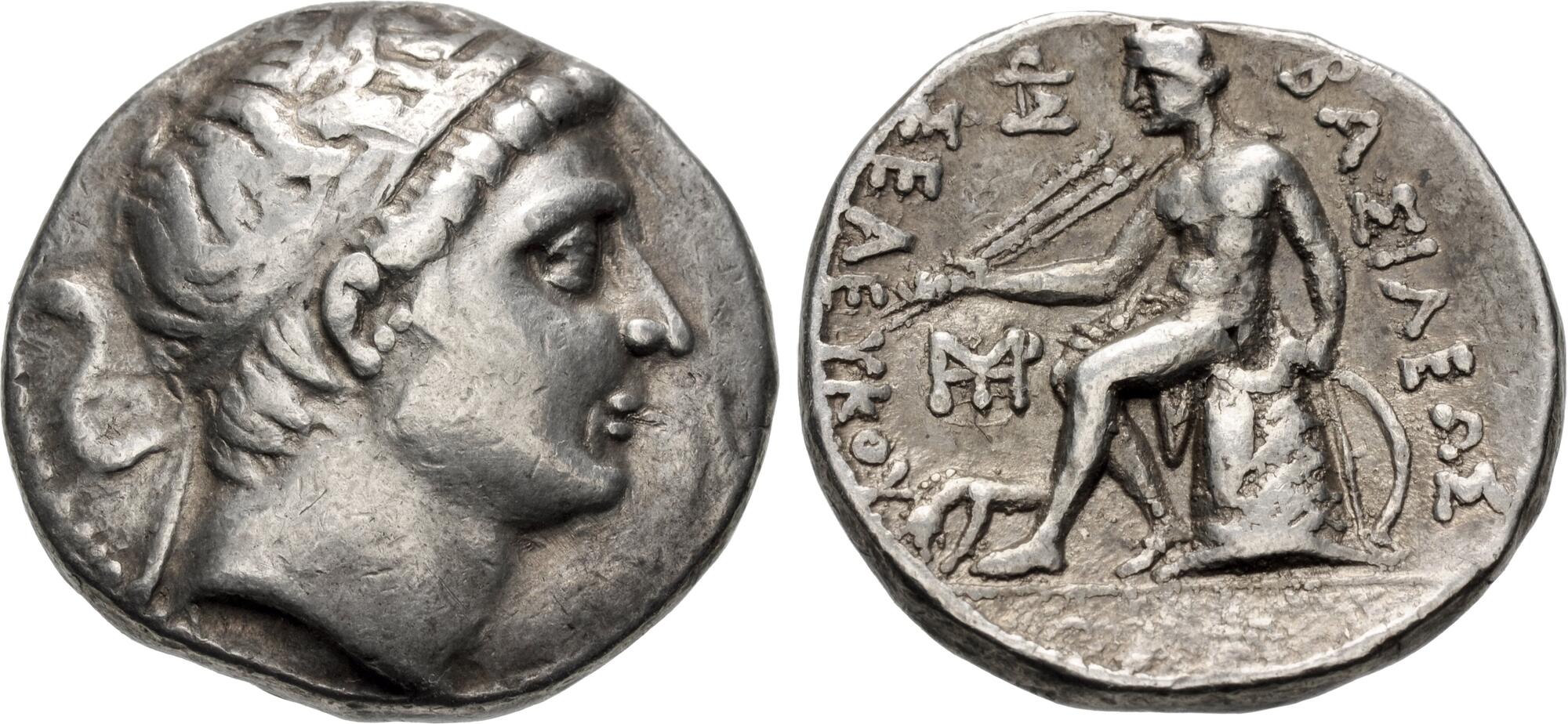Ecbatana (Seleucus II), silver, tetradrachms (Seleucus II/seated Apollo) (246-225 BCE)
From SILVER
246 BCE - 225 BCE Silver 1,491 kg
Description
| ObverseInscription or printing placed on the obverse.: | Diademed head of Seleucus II right, with sideburn |
| ReverseInscription or printing placed on the reverse.: | BAΣΙΛΕΩΣ ΣΕΛΕΥΚΟΥ (Greek).Apollo, testing arrow and resting hand on grounded bow, seated left on omphalos, to inner left, monogram above forepart of horse grazing left. |
Mint and issuing power
| MintIdentifies the place of manufacture or issue of a numismatic object.: | Ecbatana | Ancient regionAncient region.: | Media | Modern countryModern country: Iran | AuthorityIdentifies the issuing power. The authority can be "pretended" when the name or the portrait of X is on the coin but he/she was not the issuing power. It can also be "uncertain" when there is no mention of X on the coin but he/she was the issuing power according to the historical sources: | Seleucid Dynasty (312-63 BC), Seleucus II Callinicus (Seleucid king, 246-225 BC) |
Chronology
| FromIdentifies the initial date in a range assigned in a numismatic context. | 246 BCE | toIdentifies the final date in a range assigned in a numismatic context.. | 225 BCE | PeriodTime period of the numismatic object.: Hellenistic 323-30 BC |
Physical description
| MetalThe physical material (usually metal) from which an object is made.: | Silver |
Median weightMedian of the weights of numismatic objects (in grams). in grams | 17.10 | DenominationTerm indicating the value of a numismatic object. Examples: tetradrachm, chalkous, denarius.: | tetradrachm |
StandardStandard.: | Attic |
Image

Ecbatana Seleucus II tetradrachm seated Apollo.jpg [1]
References
| Die study referencePublication of the study: | Boillet 20091Boillet 2009, p. 126-128, n° 515-524. | ||
| Coin series referenceReference to coin series study: | ESM2ESM, n° 546-547, 556, HGC 93HGC 9, n° 302, SC I4SC I, n° 807 | ||
| Coin series web referenceCoin series web references: | |||
Obverse dies distribution
| FrequencyFrequency of specimen in distribution. ᵖ | Number of obversesNumber of obverse dies. ᵖ (o) | % (o) | Number of coinsNumber of coins. (n) | % (n) | Die nameName(s) of the die(s). |
| 1 | 1 | 33.33 | 1 | 14.29 | 3 |
| 2 | 1 | 33.33 | 2 | 28.57 | 2 |
| 4 | 1 | 33.33 | 4 | 57.14 | 1 |
| Total | 3 of 3 | 99.99 | 7 of 7 | 100 |
Reverse dies distribution
no distribution is available
Quantification
| Number of obversesNumber of obverse dies. ᵖ (o) | 3 | Number of singletons (o1)The number of singleton coins. ᵖ | 1 |
| Number of reverse diesNumber of reverse dies. (r) | 5 | Number of coinsNumber of coins. (n) | 7 |
| Coins per obverse dieNumber of coins per obverse die. (n/o) | 2.33 | Coins per reverse dieNumber of coins per reverse die. (n/r) | 1.4 |
| Reverse per obverse ratioRatio of obverse dies divided by reverse dies. (r/o) | 1.67 | Percentage of singletons (o1)number of coins (n) divided by the number of singletons (o1) ᵖ | 33.33 % |
| Original number of dies (O) (Carter 1983 formula)The estimation of the number of coins according to Carter 1983 ᵖ | 4.36 | Coins struck if 20,000 as average productivity per dieCoins made if the average productivity for obverses (according to Carter) is 20,000. ᵖ | 87,200 |
| Original number of dies (O) (Esty 2011 formula)The estimation of the number of coins according to the singleton formula in Esty 2011 ᵖ (O) | 5.25 | Survival rate if 20,000 as average productivity per dieSurvival rate if average productivity is 20,000. ᵖ | 0.00008 |
| Coverage (o = % of O) (Esty 1984 formula)Esty 1984 - coverage (% of O) ᵖ (o = % of O) | 85.71% | Die productivity if survival rate 1/2,000Average productivity if survival rate is 1/2,000. ᵖ | 3,211.01 |
| Weight of silver (in kg) if 20,000 coins per die (O = Carter formula)Carter 1983 * Median weight * 20000 (*10 if gold or electrum) ᵖ | 1,491 kg <br /> 1,491 kg | Die productivity if survival rate 1/5,000Average productivity if survival rate is 1/5,000. ᵖ | 8,027.52 |
Remarks
Most likely one single workstation Likely military
References
- ^ Boillet, Pierre-Yves (2009), Ecbatane et la Médie d’Alexandre aux Arsacides (c. 331 a.C. - c. 224 p.C.). Histoire monétaire et économique, unpublished doctoral dissertation, Bordeaux University.
- ^ Newell, Edawrd T. (1938), The coinage of the eastern Seleucid mints, from Seleucus I to Antiochus III, Numismatic Studies 1, New York, 307 p., LVI pl.
- ^ Hoover, Oliver D. (2009), Handbook of ancient Syrian coins : royal and civic issues, fourth to first centuries BC, The Handbook of Greek Coinage 9, Lancaster, lxix, 332 p.
- ^ Houghton, Arthur - Lorber, Catharine (2002), Seleucid coins : a comprehensive catalogue. Part 1, Seleucus I through Antiochus III, New York - Lancaster - London, 2 v. (xxxviii, 488 p. + 300 p.), 101 pl.